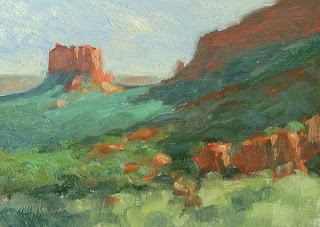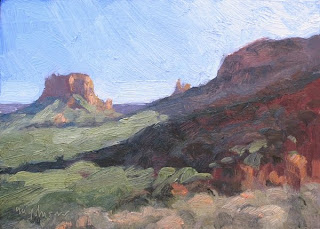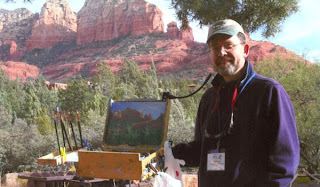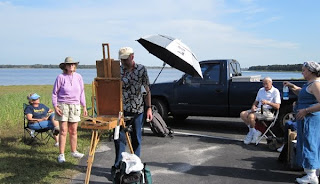Thursday, December 31, 2009
Snow and Blue
We had a bit of snow yesterday, and it's lovely to see in the shadowed sides of the mountains. The students and I rushed out this morning to paint it before it melted. The snow at the highest elevations and in the near-permanent winter shade will stick around for awhile yet.
With the bright blue skies we have here, it's tempting to make the snow shadows an intense blue. You'll definitely see such blues, but only in the nearest snow patches. Up on the mountain, a mile or so away, the color will be considerably greyed. But I did add a few touches of more intense blue up there just to add sparkle. As always, it helps to put the brush down for a moment, take a deep breath, and observe.
Wednesday, December 30, 2009
Discovering New Views
One thing I really love about Sedona is the many ways of getting into the National Forest. Much of the community abuts the Coconino National Forest in some way, and trails, both official and "social," create a broad network of painting opportunities. Although I've participated in four Sedona Plein Air Festivals and lived here last winter, I'm still adding spots to my list of secret locations.
This winter, I've discovered a hill behind the house that has a whole winter's worth of scenic views. I've been hiking it every chance I get to see what's best - and I do it with a camera. Rather than grabbing the gear and painting right away, I use the camera to explore possibilities. I take photos with the goal of not taking pretty pictures but of finding compositions. This is a very useful way of making initial explorations. Also, I also spend a significant time in not using the camera, but just looking at the scene, imagining how I might paint it. Would I move that hill slightly to the left? Would I make the light hitting that edge of that shadowed cliff brighter? And what about all those ranch buildings? How many would I include, and would I filter out the modern ones and keep the more rustic ones?
The painting is a result of this process. We had a break in the overcast, and the sun came out just long enough for me to capture the light.
Tuesday, December 29, 2009
Edgar Payne
This week, I'm rereading Edgar Payne's fine book, Composition of Outdoor Painting. This is one of the "bibles" of plein air painters. (Another is John Carlson's book, Guide to Landscape Painting.) Payne's book is one of the old-style art instruction books with tiny print and black-and-white illustrations. Although more recent editions include a few color images of his work as well as notes and examples of work by his wife and also his daughter, it's still a dense book. But it bears reading, re-reading and underlining key passages.
Since I've been writing so much about black lately - and stirring up a hornet's nest of reader comments both in my blog and on WetCanvas.com - here's what Payne has to say about black:
"Black is used a great deal in pictorial work but unfortunately it does not have real affinity with color. A neutral shade answers the purpose much better. True, an absolute neutral is almost impossible to make. Yet a dark gray made with Indian red, ultramarine blue and a portion of a yellow added makes a very satisfactory dark for the palette. This dark can be modified with other colors to suit the color scheme or with white to suit the value scale."
Payne is one of the true masters. His paintings of the Southwest go unmatched. For examples of his work, visit http://www.derusfinearts.com/wantedEDGARPAYNE.html. You can also buy his book there.
The paintings above are not, of course, Payne's but mine. The first is a pastel sketch in which I used an alcohol wash to block in the colors initially, and the second, a close-up sketch made on Kitty Wallis' Belgian Mist sanded paper. It was painted directly and without a wash. As you can tell, it was a rather overcast day!
Saturday, December 26, 2009
The Dark Side: Tonalism v. Colorism
She's right - black can be a crutch for mixing correct values, and once you start using it habitually to make darks, you've lost your way. But I was using it mostly in my lights to kill the chroma and not so much in the darks.
Or so I thought. Yesterday, Trina made an observation about my Christmas Eve painting: "Where's all that good color you always use?" Well, I liked the painting because I'd successfully held back from my sometimes over-the-top color to something much closer to reality. But like Ann, Trina was right. Color is what I get excited about, and this painting was missing it. Still, there's nothing wrong with this painting - it's just more realistic than I like to paint.
So, I went out this afternoon and did the scene again. I got to the location about an hour earlier, so the shadows were a bit different. (I also made some artistic shape changes in the rocks.) This time, I scraped the black off my palette and worked very hard to keep the color clean and pure, but without being over-the-top. I think it worked, but I'm curious: Which view do you prefer? Here's the latest version, plus the Christmas Eve one.

Friday, December 25, 2009
Christmas Eve Shadows
 "Courthouse Butte, Christmas Eve"
"Courthouse Butte, Christmas Eve"5x7, oil
Available from Windrush Gallery
As I write this early Christmas morning, a light frost covers the rocks, and all is quiet, even the coyotes. The sun has not yet risen, but it's close. A star or two still twinkles overhead. After sunrise, we're going to hike to the top of Doe Mesa to get a grand view, and then down into Fay Canyon to see a little snow. We did have snow this week, but it's mostly gone, persisting only in the shadows.
Last night I went out to paint the view above the house. It's a glorious panorama, but I chose to focus on Courthouse Butte and the long shadows cast by Cathedral Rock, just out of the frame on the right. I'm looking forward later this winter to taking a 12x24 panel up there and painting more of it.
Have a blessed Christmas, everyone.
Monday, December 21, 2009
Flying with Oils
For those of you flying for the holidays, here's some useful information if you're thinking of doing some oil painting at your destination. As you know, the Transportation Security Administration has restrictions on flammable materials. Artist's oil colors are not flammable, of course, but you should be prepared. Here's how I handle the TSA.
I double-bag my tubes in plastic bags and put them in my checked luggage along with the appropriate MSDS (Manufacturer Safety Data Sheet) documents. These data sheets will note a particular color's flash point, which is an indication of its degree of flammability.
The data sheet is handy for the TSA agent who may inspect your luggage, because it should indicate to him that the colors are non-flammable and therefore permitted. By the way, if you speak to the agent, let him know these are "artist's oil colors made with vegetable oil" and not "oil paints." It's less confusing to them.
I've found a site that has a good list of manufacturers and specific colors along with links to their MSDS documents: http://apps.risd.edu/envirohealth/msds.asp?oID=Painting
So what does define flammable?
The TSA site notes that a "flammable liquid, gel or aerosol paint" is not permitted in checked luggage. It does not, however, define "flammable." The Occupational Health and Safety Administration site, on the other hand, does.
OSHA defines a flammable liquid as "any liquid having a flash point below 100 deg. F. (37.8 deg. C.), except any mixture having components with flash points of 100 deg. F. (37.8 deg. C.) or higher, the total of which make up 99 percent or more of the total volume of the mixture." (From http://www.ilpi.com/msds/ref/flammable.html.) If you study the manufacturer's safety data sheets, you'll see that the colors cannot be classified as flammable.
With the data sheets packed with the paint in your checked luggage, your luggage should breeze through security with no problems. I've flown many times with oil paint and have had no issues. Sometimes I open a suitcase to find a little note from TSA saying the luggage was inspected, but I'm pleased to find that the paint is always still there. So, enjoy your trip!
Friday, December 18, 2009
Dominance in Contrasting Pairs
I've found that breaking down the painting process into discrete steps goes a long way to making a successful piece. For example, I like to think of the types of contrast that go into a painting and the logical order in which one might attack them. I look at value first and the amount of light and dark that I want to use. In order of attack, other contrasts include:
1. Value (light/dark)
2. Shape (round/rectangular)
3. Temperature (warm/cool)
4. Hue (think of complementary pairs such as red/green)
5. Brushwork contrasts (think of thick/thin paint, opaque/transparent passages, hard/soft edges)
You can probably think of others.
Contrast pairs should always be weighted in favor of one of the extremes. One member of the pair should cover more real estate than the other. If you look at the painting above, you can see how I approached dominance:
1. Value. My scene was a lot of light with just a little dark.
2. Shape. Most of the big shapes are prismatic with a few, smaller and rounder shapes.
3. Temperature. Most shapes are warm with the small shapes being shadowed and cooler.
4. Hue. Most of the painting lies in the blue/green part of the color wheel with less of it in the yellow/red part.
5. Brushwork. I used mostly thick, opaque paint with some thinner, more transparent passages in the shadows.
Working in this way guarantees you a painting with a lot of interesting contrasts to lure the viewer's eye.
Thursday, December 17, 2009
Scottsdale Artist's School - Best & Brightest
I did this painting for the recent Sedona Plein Air Festival. In case you missed the painting from my earlier blog post on the Festival, here it is again. Maybe I'll win a prize!
Monday, December 14, 2009
Home in Sedona
Above is my first painting of our new winter in Sedona. As those of you who follow my monthly newsletter already know, we arrived just this weekend after a nearly 4000-mile journey. We're very glad to be here! El Niño has taken the country by storm, and it's not a good time to be travelling. But here, we're expecting nothing but sun all week.
I've had scarcely time to set up the studio before my first mentoring workshop, which started today. We went out to Red Rock Crossing - just a scant half-mile from our winter lodging - to paint the Sedona icon, Cathedral Rock. I also had time to do a second painting of it, a close-up:
If you've visited Sedona or seen pictures, you'll remember the vivid red rocks. In these pictures, they're hardly vivid at all. This is because of the time of day. These were painted in early morning when the rocks were still backlit and the shadows were quite dull. As we got toward lunchtime, a lot of reflected light began to hit the shadowed sides, and they began to glow. In some ways, I prefer the more subtle, neutral colors from the early part of the day.
In both of these paintings, I used a considerable amount of Gamblin's Chromatic Black. As I've written elsewhere, this truly neutral black will both dull and darken a color without changing the hue. It's made from two pigments, phthalocyanine (PG36) and quinacridone red (PV19). These are complements and thus make a good dark. Some readers have asked, Why don't you just mix your own?, but Gamblin does a better job with their grinding mills than I ever could on my palette.
If you'd like to visit Sedona and paint this view yourself, I'll be teaching my Paint Sedona mentoring workshops all winter. In case you missed my last post on these workshops, please visit it here. I take no more than four students at a time, so it's a rare opportunity.
By the way, my 2010 portfolio is now available. This 46-page collection offers pastels and oils from my 2009 year. As with my other portfolios, it'll never be available again after next year. It costs $17 (plus shipping), or you can download it for only $9 and save the shipping. You can order it from my Lulu store.
Sunday, December 6, 2009
Sedona Bound
"Cathedral Rock Shadows" 5x7, pastel
The Paint Sedona workshops are for the serious student who's got some outdoor painting experience under his belt and wants to climb higher in his skill. You'll have the chance to learn the finer elements of painting and get information that usually isn't handled in a regular workshop. But it's not just about advanced instruction. It's an opportunity to address issues that are bigger than mere craft. Here are some other things the workshop can do:
- Give your art a mid-course correction
- Create an action plan for the future
- Define where your career is headed
In the past four years, I've painted in Sedona as one of 30 nationally-known artists in the annual Sedona Plein Air Festival invitational. I also lived in Sedona last winter and had a very enjoyable Paint Sedona season. In my explorations, I created a long list of great painting spots. I'd like to share them with you. For more information, please visit http://www.paintsedona.com/.
My next post will most likely be from Sedona. Happy travels! - Michael

Friday, December 4, 2009
Sarasota Plein Air Workshop - Day 5
The rain finally came, and in buckets, but not until we had a couple of hours painting in the resort. We secured a room for back-up in case it rained, and then we headed across the parking lot to something called the "Butterfly Garden." This little garden occupies a prime spot along a small pond, and a variety of flowers that butterflies love are planted there. One plant I like a great deal is the croton. It doesn't seem to bloom, but the foliage can be quite spectacular. Green and magenta make a dynamic combination, especially on an overcast day when colors seem more intense.
I did a pastel demonstration of this plant. Someone asked how I was planning to render all the leaves. The idea is to not render *all* the leaves - just a few key ones. The mind will see the more-rendered ones and make the assumption that the rest of the foliage is similar. So, I first blocked in the dark green mass of the crotons first, added the pinkish-magenta bits to suggest some of the more colorful foliage, and then took a little more care in delineating a few.
As I started the second piece, the sky darkened noticeably and I knew rain was only moments away. I did a quick sketch of some of the more modern "park models" here - and included the tall cell tower behind them. It's a post-modern look at a landscape, but sometimes I enjoy putting in this kind of thing.
At the end of this week's workshop, someone asked me to give five helpful tips for painters. I narrowed it down to these general concepts that can apply to any level of painter:
- Keep your gear portable. You won't paint if your gear isn't always ready-to-go.
- Paint often. A violinist doesn't play just when giving a concert.
- Work from life. All the answers are out there.
- Look at a lot of art. This will help you develop a sense of what works and what doesn't.
- Find friends to paint with. Camaraderie and feedback are meat and drink to the artist.
Thursday, December 3, 2009
Sarasota Plein Air Workshop - Day 4
The weather can turn fast here in the Gulf. We went to bed last night under a tornado watch. About one in the morning, an explosion of thunder woke us up, and then the rain pummelled down. By dawn, the rain had stopped and a patch of blue sky appeared. Still, the forecast was for showers, so we decided to paint close to home - just in case.
I decided to paint a study of one. It didn't have the mature garden, but it does have a classic look. For this kind of painting, a broad brush stroke is necessary. A brush stroke accurately placed would be like levelling the floors in a 200-year-old Cape - it ruins the charm. (You still want to get the value and temperature relationships right, though.)
Wednesday, December 2, 2009
Sarasota Plein Air Workshop - Day 3
The threat of thunderstorms and high winds didn't deter us from our goal today - Coquina Beach at the south end of Anna Maria Island. Bad weather wasn't expected until afternoon, so we figured we'd be able to get out there and back before the action began. Our luck held out, and we had a good morning. We made sure to stay on the lee side of the island, since the white caps were kicking up on the west side and we wanted to avoid any umbrella-induced disasters.
Coquina Beach has a wonderful natural area, complete with hiking trail, that lets you explore the water's edge. Mangrove and sea grape, herons and pelicans, and lots of shells characterize it. A couple of the students painted a great blue heron that posed rock-still for nearly two hours. A passerby asked them if they had paid the heron to pose.
For my demonstration, I chose a view of an Australian pine among the dunes. ("What, no water?" one student asked. No, because I'd need a much longer canvas to get my pine and the water in, too.) I wanted to show one method of avoiding shifting values in an oil painting. As most oil painters know, anytime you add a color to a particular mixture, you change the value, whether you mean to or not. It's so easy to get the much-dreaded "value shift" and to lose your design.
I analyzed my scene and came up with five distinct values. Using a painting knife, I pre-mixed piles of paint that matched those values. I had three values of green for vegetation, one light blue for the sky and then, for my lightest light, a sand color. The idea is that, no matter what other color mixtures you end up making, those color mixtures must match the value of one of these five piles.
Although pre-mixing paint can take some time, the painting itself goes much faster once you're done. The painting, as they say, almost paints itself. Just make sure you put the paint where you want it. For this demonstration, which depicts a slightly-overcast moment with no well-defined shadows or highlights, it went very fast. In 30 minutes, the painting was nearly done. Another 10 minutes go it to where you see it now. It is a good sketch that could be taken to the studio and fine-tuned or that could have a larger studio piece based on it.
Tuesday, December 1, 2009
Sarasota Plein Air Workshop - Day 2

For the second day of the workshop, we headed out to Myakka River State Park. It's probably one of my favorite places here to paint in. The road takes you through woods so dense with live oak and cabbage palm that it's like driving through a tunnel, and then suddenly you pop out into the sunlight with a vista. Several pull-offs give you good views of the river snaking off into the distance. Where the live oaks end, the palms take over; where the palms end, the marsh grasses spring up; and then in the water you see ibis, egrets, wood storks and sandhill cranes.
After a quick stop on the main bridge to see some alligators snoozing in the café au lait water, we drove on to the concession area. Here, you can tour Myakka Lake on an airboat or, if you dare, venture out with a canoe or kayak. (Can alligators upset a canoe?) Trails lead you into the woods and then to a dam built in 1934 by the Civilian Conservation Corps. By this dam last year, I watched some locals fishing for tilapia with nets. But I always love the trees here - massive, muscular live oaks festooned with Spanish moss.
Early in the day, I did one 5x7 oil demo for the group, focussing on the shadow shapes cast by the oaks and palms on a field of grass. Later, as the day grew hot, I did a second painting, which is featured below. The students remarked that the brush work and color on this one was much more vigorous and enjoyable. I told them, truthfully, that I painted it that way because I had gotten tired. When I get tired, I think less and shoot more from the hip. It'd be nice to be able to paint this way all the time. (But without actually being tired, of course!)
For this painting, I skipped any thumbnail sketch or underpainting. I wanted to get right down to business. With a scene as contrasty as this, and which already has strong design elements, it's easy to wing the composition. It's more fun that way. Also, I didn't want to lose time with the underpainting, so I mixed my colors exactly the way I wanted them - even using white when necessary - and applied them directly. For "direct painting," you can't get any more "direct" than this.
In the middle of the day, we headed to the little restaurant for seafood gumbo. Gator stew was also on the menu, but I don't think anyone was brave enough. I try not to eat anything bigger than me.
More Art & Painting Blogs | (List Culled Periodically of Non-Posters!)
-
-
-
Painting Ghost Rider2 days ago
-
THE END OF 20256 days ago
-
-
Figuring Out the Format of Dinotopia2 weeks ago
-
-
-
















